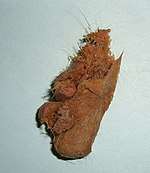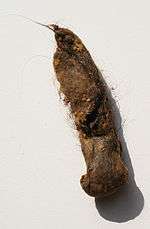Hairball
A hairball is a small collection of hair or fur formed in the stomach of animals, and uncommonly in humans, that is occasionally vomited up when it becomes too big. Hairballs are primarily a tight elongated cylinder of packed fur, but may include bits of other elements such as swallowed food. Animals with hairballs are sometimes mistaken as having other conditions of the stomach such as lymphosarcoma, tuberculosis, and tumor of the spleen.[1] Cats are especially prone to hairball formation since they groom themselves by licking their fur, and thereby ingest it. Rabbits are also prone to hairballs because they groom themselves in the same fashion as cats, but hairballs are especially dangerous for rabbits because they cannot regurgitate them. Due to the digestive systems of rabbits being very fragile, hairballs in rabbits must be treated immediately or they may cause the animal to stop feeding and ultimately die due to dehydration. Cattle are also known to accumulate hairballs but, as they do not vomit, these are found usually after death and can be quite large.


Clinical significance
A trichobezoar is a bezoar (a mass found trapped in the gastrointestinal system) formed from the ingestion of hair. Trichobezoars are often associated with trichotillomania (compulsive hair pulling).[2] Trichobezoars are rare, but can be fatal if undetected.[3][4][5][6] Surgical intervention is often required.[3][7]
Society and culture
Although uncommon in humans, some hairballs have been reported. These hairballs occur when hair strands collect in the stomach and are unable to be ejected as a result of the friction on the surface of the gastric mucosa.[8] Hairballs are often seen in young girls as a result of trichophagia, trichotillomania, and pica.[9] In 2003, a 3-year-old girl in Red Deer, Alberta, Canada, had a grapefruit-sized hairball surgically removed from her stomach;[10] in 2006, an 18-year-old woman from Chicago, Illinois, had a 4.5 kg (9.9 lb) hairball surgically removed from her stomach;[11] and in 2014, a 9-pound hairball was removed from the stomach of an 18-year-old in Kyrgyzstan.[12] Hairballs can be quite hazardous in humans[13] since hair cannot be digested or passed by the human gastrointestinal system, and (assuming it is identified) even vomiting may be ineffective at removing the hair mass. This can result in the general impairment of the digestive system.
See also
References
- Rolleston, JD (1924). "Specimen of Hair-ball of the Stomach". Proceedings of the Royal Society of Medicine. 17 (Section for the Study of Disease in Children): 5–8. PMC 2201872. PMID 19984083.
- Sah DE, Koo J, Price VH (2008). "Trichotillomania" (PDF). Dermatol Ther. 21 (1): 13–21. doi:10.1111/j.1529-8019.2008.00165.x. PMID 18318881.
- Gorter RR, Kneepkens CM, Mattens EC, Aronson DC, Heij HA (May 2010). "Management of trichobezoar: case report and literature review". Pediatr. Surg. Int. 26 (5): 457–63. doi:10.1007/s00383-010-2570-0. PMC 2856853. PMID 20213124.
- Ventura DE, Herbella FA, Schettini ST, Delmonte C (2005). "Rapunzel syndrome with a fatal outcome in a neglected child". J. Pediatr. Surg. 40 (10): 1665–7. doi:10.1016/j.jpedsurg.2005.06.038. PMID 16227005.
- Matejů E, Duchanová S, Kovac P, Moravanský N, Spitz DJ (September 2009). "Fatal case of Rapunzel syndrome in neglected child". Forensic Sci. Int. 190 (1–3): e5–7. doi:10.1016/j.forsciint.2009.05.008. PMID 19505779.
- Pul N, Pul M (1996). "The Rapunzel syndrome (trichobezoar) causing gastric perforation in a child: a case report". Eur. J. Pediatr. 155 (1): 18–9. doi:10.1007/bf02115620. PMID 8750804.
- Dehghan A, Moaddab AH, Mozafarpour S. "An unusual localization of trichobezoar in the appendix." Turk J Gastroenterol. 2011 Jun;22(3):357-8.
- Santiago, Sanchez CA (1996). "Trichobezoar in a 11-year old girl: a case report". Boletin de la Asociacion Medica de Puerto Rico. 88 (1–3): 8–11. PMID 8885440.
- Hairballs: Myths and Realities behind some Medical Curiosities Archived 2009-11-21 at the Wayback Machine, National Museum of Health and Medicine, Washington, D.C.
- "Talk about a Hairball!!!". Forums.dealofday.com. 2003-11-13. Archived from the original on 2011-09-30. Retrieved 2011-02-09.
- Levy, Ronald M; Komanduri, Srinadh M (2007). "Trichobezoar". New England Journal of Medicine. 357 (21): e23. doi:10.1056/NEJMicm067796. PMID 18032760.
- Dodds, Laurence. "Huge 9lb hairball removed from teenage girl's stomach." The Telegraph. September 30, 2014.
- Girl died from eating her hair, BBC News, 1999-08-20